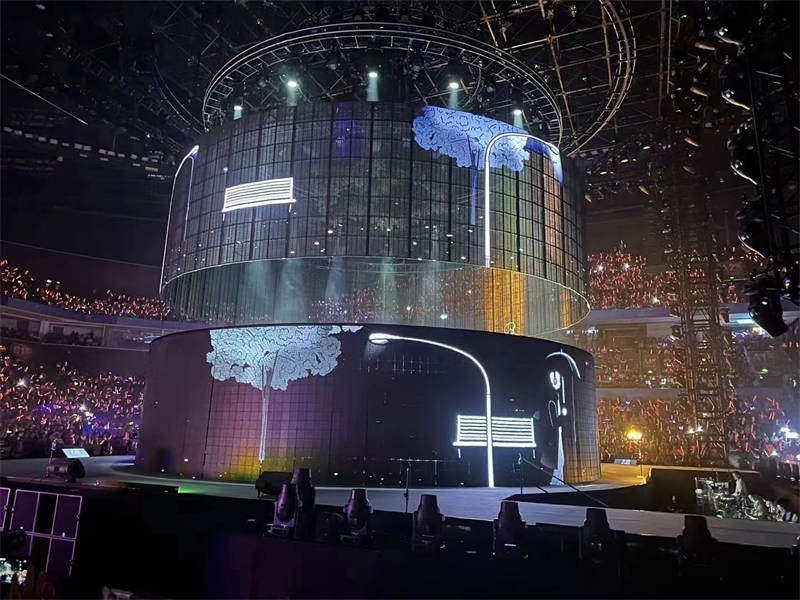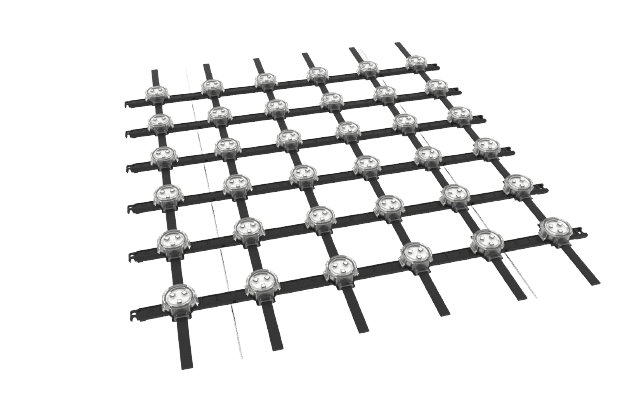Transparent LED screen and LED mesh screen are new types of LED displays, both of which are transparent displays. Although both have hollow designs based on traditional LED displays, they have significant differences in design principles, application fields, performance characteristics, and installation environments. SightLED will explore these differences.
Table of Contents
ToggleWhat is LED mesh screen?

LED mesh screen, also known as grid screen,curtain screen, hollow screen, etc. It is an LED display screen with light strips as the basic unit. This LED screen adopts an all-aluminum profile design for the outer frame, which is ultra-light and ultra-thin, and the structure is hollowed out, which can transmit light and air, and has strong wind pressure resistance. LED curtain screens are widely used in building curtain walls, building tops and outdoor advertising scenes.
Transparent LED screen and LED mesh screen Application

With hollow design, transparent screens and LED mesh screens can transmit light. Transparent screens were originally mostly used for indoors display and were not waterproof. The pixel pitch is relatively small, and can be used for large and small areas.
LED mesh screens are mostly designed with light strips, and are mostly waterproof for outdoor application, with relatively large pixel pitch. They are mostly used for outdoors. They are waterproof and moisture-proof, and have better protection. They are generally used in large areas. Later, with the development of LED display technology, transparent screens were also waterproofed and can also be used outdoors. They are called waterproof transparent screens. The pixel pitch is small and the clarity is high.
Therefore, when choosing them, mesh screens are generally used for large outdoor waterproof areas. For medium or smaller areas, waterproof transparent screens are mostly used.
In addition, they have the following similarities and differences.
Transparent LED screen and LED mesh screen similarities
| LED Transparent Screen | LED Mesh Screen | |
|---|---|---|
| Design Principle | Based on conventional LED screens, adopts a hollow-out design to remove redundant parts. The hollow structure between light bars reduces weight while providing a certain level of transparency. | Similar to LED Transparent Screen, it also utilizes a hollow-out design to remove unnecessary parts. The gaps between light bars lighten the display and offer transparency. |
| Weight | Lighter than conventional LED screens due to the hollow-out design. | Also lighter than conventional screens, owing to the same hollow-out design approach. |
| Transparency | Offers a certain degree of transparency, allowing light to pass through. | Provides similar transparency, allowing visibility through the screen. |
| Application Areas | Can be installed on locations with glass curtain walls. Ideal for use where high transparency is required without compromising indoor lighting. Lightweight design makes it suitable for structures with less stringent requirements. | Similarly suitable for installation on glass curtain walls. Maintains indoor lighting while displaying content. Lightweight, making it compatible with various structural requirements. |
| Key Advantages | – High transparency for natural light penetration – Lightweight, reducing structural load – Suitable for indoor and outdoor use with glass facades | – Similar transparency and lightweight benefits – Versatile for various architectural installations – Enhances visual appeal of buildings |
Transparent LED screen and LED mesh screen differences
Here’s the differences between LED Transparent Screens and LED mesh Screens:
| LED Transparent Screens | LED Mesh Screens | |
|---|---|---|
| LED Bead Type | SMD Beads | DIP Beads |
| Description | Higher pixel density for clearer images, commonly available in P3.9, P7.8, P10.4, etc. Ideal for indoor installation with outdoor visibility. | Lower pixel density due to larger pitch, typically P15 and above. Uses high-brightness straight insertion beads for outdoor environments. |
| Installation Environment | Indoors, with outdoor viewing capability | Outdoors |
| Waterproof Rating | Lower requirement, typically IP34 due to indoor installation | High requirement, must meet IP65 for waterproof and dustproof capabilities in outdoor settings |
| Weight | Lighter, with weights as low as 7KG/sqm due to thinner LED strips and borderless design. | Heavier, averaging around 20KG/sqm due to additional weight from encapsulation for waterproofing and heavier materials like cold-rolled steel or die-cast aluminum for the cabinet. |
| Key Advantages | High transparency, lightweight, and suitable for indoor spaces requiring a blend with the environment. Provides excellent visual experience even from a distance. | High brightness, suitable for large outdoor displays in various weather conditions. Ideal for large-scale advertising and information dissemination. |
| Applications | Retail showcases, glass partitions, museums, aquariums, event staging, etc. | Outdoor advertising billboards, stadium screens, building facades, roadside displays, etc. |
How much does an LED mesh screen cost per square meter?

Are you curious about how much an LED mesh screen costs per square meter? Let’s uncover the mystery of the price together!
The LED mesh screen price is not fixed. It is like a customized work of art, and the price varies according to the model, pixel spacing and transparency. Generally speaking, the LED mesh display screen is about US$500 to US$8500 per square meter. The specific outdoor pixel pitch reference is as follows:
| Pixel Pitch | LED Type | Brightness (nits) | Transparency Rate | Estimated Price (USD/sqm) |
|---|---|---|---|---|
| P31.25 | SMD3535 / SMD5050 | 6000 – 9600 | 70% – 80% | $680 – $850 |
| P41.67 | SMD3535 / SMD5050 | 6000 – 9000 | 75% – 85% | $620 – $750 |
| P50 | SMD5050 | 7000 – 9600 | 65% – 75% | $580 – $700 |
| P55 | SMD5050 | 8000 – 9600 | 60% – 70% | $550 – $650 |
| P71.43 | SMD5050 | 6000 – 8000 | 55% – 65% | $500 – $600 |
✅ Note: Prices above are FOB China, based on standard high-brightness, IP65 outdoor mesh LED screens with static scan and industrial-grade components. Additional customization (e.g. curved shapes, ultra-lightweight aluminum frames, or NovaStar control systems) may affect the final pricing.
It is worth noting that the LED mesh screen system cost is far more than the screen itself. Although the LED screen cost accounts for more than 60% of the total project investment,.You also should not be ignore the supporting equipment, system engineering and other costs. A stable computer, an efficient power distribution cabinet, a professional video processor, and sophisticated installation and debugging services will add a lot of extra costs.
In addition, when choosing an LED mesh screen, you should not only pay attention to its price, but also comprehensively consider factors such as cost-effectiveness, service quality, and after-sales guarantee.
SightLED LED mesh screen Solution

Advantages and characteristics of Our mesh screens
Light and transparent: The SightLED mesh screen adopts an all-aluminum profile design, which is ultra-light and ultra-thin, which can greatly reduce the weight and thickness of the entire LED display screen. At the same time, the hollow structure of the cabinet makes the LED curtain screen transparent and ventilated, increasing the visual effect and transparency.
High brightness and energy saving: The brightness of the LED screen can reach up to 10,000cd/㎡. It uses high-efficiency, high-brightness, good-quality LED lights and high-conversion efficiency power supplies. The average power consumption per hour is about 150W/㎡. The dissipates heat naturally, without air conditioning, and has the advantages of green energy saving.
Easy maintenance: The structural design is simple and light, and it is very convenient to install and maintain. It can achieve front/rear maintenance, reducing maintenance costs and difficulties.
High protection design: The mesh screen achieves a waterproof grade of IP65, and has multiple protection functions such as waterproof, dustproof, fireproof, low temperature, high temperature, lightning protection, and corrosion protection, which can adapt to various harsh outdoor environments. At the same time, the cabinet can be customized in various shapes such as arcs and cylinders to meet the diverse needs of owners and designers.
Sample Customer Outdoor Mesh screen Inquiry + Quotation
Customer Inquiry:
Hello,
We are looking to purchase a 120 sqm outdoor LED mesh screen for a building façade project. The installation height is over 70 meters, so we need high brightness (minimum 6000 nits), lightweight construction, and strong wind-resistance with transparency. Please suggest the most suitable configuration and provide us with a detailed quotation. Thanks!
Sales Team Reply with Quotation:
Dear [Customer Name],
Thank you for your inquiry. Based on your high-altitude outdoor installation, strong sunlight exposure application. It emphasis on transparency and durability, we recommend the following configuration:
Recommended Configuration
- Model: Outdoor LED Mesh Screen
- Pixel Pitch: P41.67 mm
- LED Type: SMD5050 (High Brightness Grade)
- Brightness: Up to 9000 nits
- Transparency: ≈ 80%, ideal for wind resistance
- Panel Size: 500mm (customizable)
- Scan Mode: Static
- Color Depth: 16-bit grayscale
- Refresh Rate: 1920–3000Hz
- IP Rating: IP67 (Front and Rear)
- Max Power Consumption: 550 W/sqm
- Lifetime: 100,000 hours
- Weight: ~3.5–4.0 kg/sqm
- Viewing Angle: 140°(H) / 110°(V)
- Input Voltage: 15V DC; Main Supply: 100–240V AC
- Quotation (FOB China Port)
- Unit Price: USD $720/sqm
- Total (120 sqm): USD $86,400
- Lead Time: 20–25 working days
- Warranty: 1 Years (extendable upon request)
- Free Spare Parts: 2% modules, power supplies & connectors included
- Optional: NovaStar/Colorlight controllers, frame kits, power distribution cabinet
This LED mesh display configuration offers excellent visibility, strong weather resistance, and easy integration for large-scale architectural facades. With modular design, it can be fast installation and maintenance. If your project involves a curved surface or creative installation shape, we also offer flexible and bendable mesh LED options.
Please advise your required delivery time and destination port so we can provide further shipping and logistics details. Looking forward to supporting your project.
Best regards,
[Your Name]
Conclusion:
Both transparent LED screens and mesh screens have the advantages of high transparency, lightness, high brightness, color reproduction, energy saving and environmental protection. They are widely used in commercial display, architectural decoration, creative display and other fields, while mesh screens are more suitable for outdoor advertising and building curtain wall advertising.
Both have their own advantages, and you can choose the appropriate LED display technology according to your actual needs. As a professional LED screen manufacturer, SightLED can provide a variety of transparent and mesh screen solutions. If you need them, please feel free to contact us.







